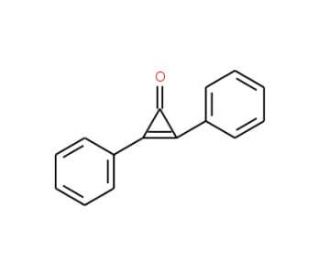

Diphenylcyclopropenone (CAS 886-38-4)
QUICK LINKS
Diphenylcyclopropenone is a compound that plays a significant role in the study of photochemistry and organic synthesis. It is an active research chemical used to investigate the characteristics of cyclopropenone derivatives, which are known for their highly strained three-membered ring structure. In the domain of synthetic chemistry, Diphenylcyclopropenone is employed as a precursor for the synthesis of more complex organic compounds, serving as a building block that can undergo various chemical transformations due to its reactive nature. The compound′s ability to participate in [2+2] cycloadditions is of particular interest, providing insights into reaction mechanisms and kinetics. Additionally, Diphenylcyclopropenone is used in the study of molecular electronics, where its conjugated system and distinctive geometry may contribute to the development of new materials with specific electronic properties. Researchers also explore the photophysical properties of this compound, such as its absorption and emission spectra, to further understand the behavior of cyclopropenones upon exposure to light.
Diphenylcyclopropenone (CAS 886-38-4) References
- Diphenylcyclopropenone-induced vitiligo in a patient with alopecia universalis. | Riad, H., et al. 2013. Case Rep Dermatol. 5: 225-31. PMID: 24019775
- Extensive scalp angioedema following high-dose diphenylcyclopropenone for alopecia areata. | Buchanan, R., et al. 2014. Hosp Pharm. 49: 48-51. PMID: 24421563
- Diphenylcyclopropenone in patients with alopecia areata. A critically appraised topic. | Kuin, RA., et al. 2015. Br J Dermatol. 173: 896-909. PMID: 26511831
- Topical immunotherapy with diphenylcyclopropenone-induced vitiligo. | Kutlubay, Z., et al. 2016. J Cosmet Laser Ther. 18: 245-6. PMID: 26963903
- Review of treatment for alopecia totalis and alopecia universalis. | Kassira, S., et al. 2017. Int J Dermatol. 56: 801-810. PMID: 28378336
- Systematic review and quality analysis of studies on the efficacy of topical diphenylcyclopropenone treatment for alopecia areata. | Jang, YH., et al. 2017. J Am Acad Dermatol. 77: 170-172.e1. PMID: 28619558
- Diphenylcyclopropenone-induced psoriatic koebnerization. | Cardis, MA. and Moshell, AN. 2018. Int J Dermatol. 57: 492-493. PMID: 29345301
- Diphenylcyclopropenone for alopecia areata: a U.K. survey. | Karanovic, S., et al. 2018. Br J Dermatol. 179: 514-515. PMID: 29480935
- Diphenylcyclopropenone plays an effective therapeutic role by up-regulating the TSLP/OX40L/IL-13 pathway in severe alopecia areata. | Gong, Y., et al. 2021. Exp Dermatol. 30: 278-283. PMID: 33325128
- The Role of Serum Th1, Th2, and Th17 Cytokines in Patients with Alopecia Areata: Clinical Implications. | Waśkiel-Burnat, A., et al. 2021. Cells. 10: PMID: 34943905
- Economic Impact of Home-Use versus Office-Use Diphenylcyclopropenone in Extensive Alopecia Areata. | Lekhavat, C., et al. 2022. Skin Appendage Disord. 8: 108-117. PMID: 35419425
- Depigmentation Following Diphenylcyclopropenone Immunotherapy Leading to Discontinuation of Treatment. | Hanumanthu, V., et al. 2022. Int J Trichology. 14: 144-146. PMID: 36081437
- A unique reaction of diphenylcyclopropenone and 1,2-aminothiol with the release of thiol for multiple bioconjugation. | Liu, S., et al. 2023. Chem Commun (Camb). 59: 1497-1500. PMID: 36655850
Ordering Information
| Product Name | Catalog # | UNIT | Price | Qty | FAVORITES | |
Diphenylcyclopropenone, 1 g | sc-255115 | 1 g | $47.00 | |||
Diphenylcyclopropenone, 5 g | sc-255115A | 5 g | $152.00 |
